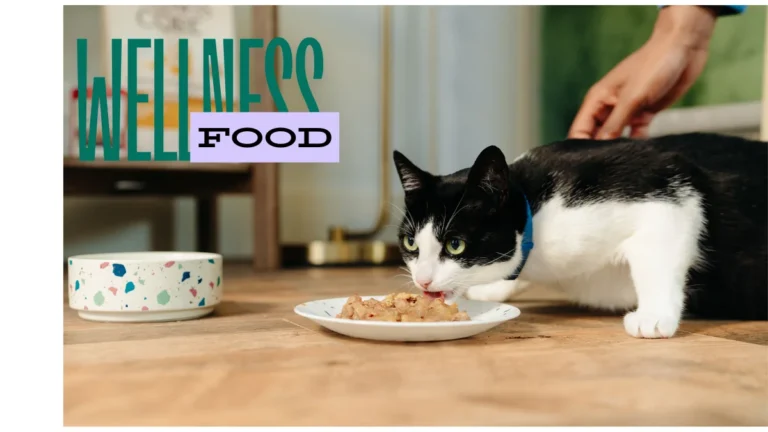Introduction:
Wet canned cat food is a popular choice among cat owners due to its high moisture content and palatability. Its benefits for a cat’s health make it an appealing option.
This article will explore why wet canned food can be an excellent choice for your feline companion. We’ll compare it to dry food, examine the different types available, and offer tips on selecting the best options for your cat.
Why Wet Canned Cat Food is a Popular Choice for Cats
The Importance of Moisture in a Cat’s Diet
Cats are obligate carnivores, which means they rely heavily on animal-based proteins and have a low thirst drive due to their desert-dwelling ancestors. In the wild, cats derive a significant portion of their moisture needs from the prey they hunt. In a domestic setting, wet canned food mimics this natural intake of water. Dehydration in cats can lead to a variety of health issues, such as urinary tract infections (UTIs) and kidney disease, so offering wet canned food is an effective way to ensure your cat stays hydrated.
Wet canned cat food typically contains around 70-80% moisture, much higher than the 10% moisture content in dry kibble. This high moisture content helps to support healthy kidney function and promotes overall hydration. Cats who primarily eat dry kibble often do not compensate for the lack of water in their diet by drinking more from their bowl. Over time, this can lead to chronic dehydration, which increases the risk of serious health issues.
Additionally, cats tend to prefer the texture and taste of wet food due to its close resemblance to natural prey. The higher palatability ensures they get the nutrition they need, especially for cats who are picky eaters or have lost interest in dry food.
Nutritional Benefits of Wet Canned Cat Food
Wet canned cat food tends to be rich in animal proteins and contains fewer carbohydrates than dry food. Since cats require high protein and low carbohydrate diets, wet food can better align with their nutritional needs. Moreover, wet food is usually made from real meat or fish, providing a more natural diet for your cat.
Protein is crucial for maintaining a cat’s lean muscle mass and energy levels, while fats help support a shiny coat and healthy skin. Wet food’s high moisture and protein content can be especially helpful for senior cats, who may struggle with dental issues and need a softer, more digestible option.
Comparing Wet Canned Cat Food to Dry Cat Food
The Case for Wet Food
Wet and dry cat food options each have their benefits, but wet canned food often excels in certain areas. One significant advantage is its high moisture content, which supports urinary health. This is particularly important for male cats, who are more prone to urinary crystals and blockages. For cats that have experienced conditions like feline lower urinary tract disease (FLUTD), the added hydration from wet food can be beneficial.
In addition, wet canned cat food more closely resembles a cat’s natural diet. This means it typically provides better-quality protein. The texture and flavor of wet food can also stimulate a cat’s appetite, making it a good option for picky eaters or those recovering from illness.
The Benefits of Dry Cat Food
Dry cat food, on the other hand, does have its advantages, particularly in terms of convenience. It is easy to store, less expensive per serving, and can be left out for long periods without spoiling, making it ideal for cat owners who work long hours or travel frequently. Dry food is also beneficial for dental health, as the crunchy texture can help clean a cat’s teeth as they chew, reducing the risk of plaque and tartar buildup.
The Best Approach: A Mixed Diet?
Many veterinarians recommend a mixed diet, incorporating both wet and dry food to provide the best of both worlds. A combination diet allows your cat to benefit from the moisture and protein of wet food while enjoying the convenience and dental benefits of dry food. Mixing the two may also prevent your cat from becoming bored with their food, ensuring they maintain a healthy appetite.
How to Choose the Best Wet Canned Cat Food
Read the Labels: What Ingredients to Look For
Choosing the best wet canned cat food for your feline friend requires understanding the ingredient list. Look for foods with high-quality, animal-based proteins listed as the first ingredient, such as chicken, beef, turkey, or fish. Avoid products with vague labels like “meat by-products” or “animal digest,” as these often contain lower-quality protein sources. Cats need amino acids like taurine, which are only found in animal tissues, to support heart health, vision, and overall vitality.
Also, pay attention to the carbohydrate content. Cats do not need grains or plant-based fillers, so it’s best to choose foods that have limited or no grains like corn or wheat. Many premium brands offer grain-free options that are closer to what cats would naturally eat.
Choose According to Your Cat’s Life Stage
It’s also essential to choose wet canned cat food that is appropriate for your cat’s life stage. Kittens, adults, and senior cats have different nutritional needs. Kittens require food rich in protein and fat to support their rapid growth and development. Adult cats need balanced nutrition to maintain lean muscle mass and energy levels, while senior cats may benefit from diets lower in fat but higher in easily digestible proteins to prevent weight gain and support aging joints.
Common Myths About Wet Canned Cat Food
“Wet Food is Bad for Cats’ Teeth”
One of the most common myths about wet canned cat food is that it can cause dental problems in cats. However, while dry food can help with dental health, wet food does not necessarily harm teeth. It’s essential to understand that dental issues in cats are often caused by other factors, such as genetics, poor oral hygiene, or a lack of routine dental care. Regular brushing of your cat’s teeth and veterinary dental cleanings can help prevent any issues, regardless of whether you feed them wet or dry food.
“Wet Food is Too Expensive”
Another common myth is that wet canned cat food is too expensive compared to dry food. While wet food may seem pricier per can, it can be more nutritionally dense, meaning you may not need to feed as much to meet your cat’s dietary needs. Additionally, many affordable options provide high-quality nutrition, so it’s possible to feed your cat a wet food diet without breaking the bank. When considering the long-term health benefits, such as reduced risk of dehydration-related illnesses, wet food can be a cost-effective choice.
Specialized Wet Canned Cat Food Options
Wet Food for Cats with Special Dietary Needs
Not all cats have the same nutritional requirements, and many commercial brands offer specialized wet food formulas designed to address specific health concerns. For example, some wet foods are formulated for weight management, containing fewer calories and higher fiber to help cats maintain a healthy weight. Others are designed for cats with urinary tract issues, with reduced magnesium and balanced pH levels to promote urinary health.
Cats with food allergies or sensitivities can benefit from limited-ingredient or hypoallergenic wet canned foods. These foods eliminate common allergens like chicken or grains and use alternative protein sources like duck, rabbit, or venison.
Prescription Wet Canned Cat Food
For cats with chronic health conditions like diabetes, kidney disease, or gastrointestinal issues, prescription wet canned cat food may be recommended by a veterinarian. These diets are specially formulated to manage specific medical conditions and should only be fed under veterinary supervision.
How to Transition Your Cat to Wet Canned Food
Tips for a Smooth Transition
Transitioning your cat from dry to wet food can take some time and patience, especially if they’ve become accustomed to the texture and flavor of kibble. Start by mixing a small amount of wet food with their regular dry food, gradually increasing the proportion of wet food over several days or weeks. Cats can be resistant to change, so be patient and give them time to adjust.
Ensure the food is at room temperature, as cats are more likely to eat food that smells appetizing. If your cat still refuses wet food, try different flavors or brands until you find one they enjoy.
Addressing Common Challenges
Some cats are picky eaters, and the transition to wet food may be challenging. If your cat refuses wet food, try adding a small amount of tuna juice or low-sodium chicken broth to make it more enticing. Another common issue is leaving wet food out for too long. Wet food can spoil quickly, so it’s important to remove any uneaten food after about 20-30 minutes. Offering smaller, more frequent meals can help reduce waste.
FAQ:
How much wet canned cat food should I feed my cat?
The amount of wet canned cat food to feed your cat depends on several factors, including their age, weight, activity level, and overall health. Most adult cats require about 200–250 calories per day, which is usually the equivalent of one 5.5-ounce can of wet food. However, this can vary by brand and your cat’s specific dietary needs. It’s best to follow the feeding guidelines on the packaging or consult your veterinarian for personalised recommendations.
Can I leave wet cat food out all day?
No, wet cat food should not be left out all day. Wet food spoils much faster than dry food, especially once it’s been opened and exposed to air. Leaving it out for extended periods can lead to bacterial growth, which may upset your cat’s stomach or cause illness. It’s recommended to leave wet food out for no longer than 20-30 minutes at room temperature, then refrigerate any leftovers for future use.




